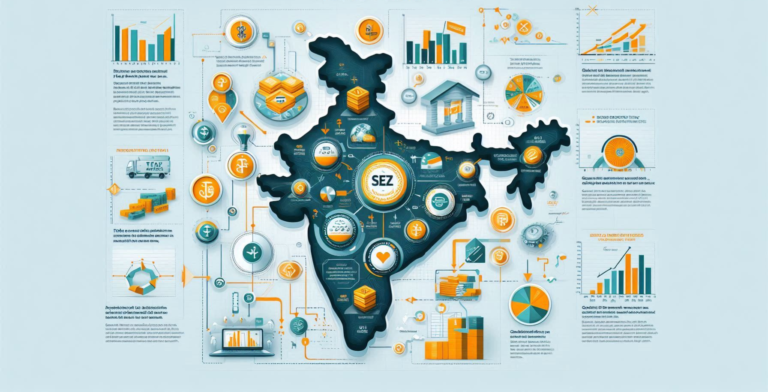
Abstract
Hallyu or Korean wave is a Cultural wave from Seoul, Korea that is captivating hearts of people worldwide with its addictive K-pop beats, dreamy K-dramas, stylish Korean fashion and perfect K-beauty .Indian youth are swept away by the tsunami of the alluring Korean dramas breaking all barriers of watching.
Excessive consumption of K-Dramas among Indian youth has been linked to multiple problems of which triad of threats considered here are skewed perception, procrastination and vernacular erosion. Previous studies have demonstrated that there are certain impacts of over-indulgence that causes addiction and apparently imitation or aspiration that not only hampers the productivity but also may create illusions. This Qualitative research identifies the adverse effects of over-consuming Korean dramas on Indian Youth in terms of aforementioned factors.
Our findings indicate that there is a significant impact of binge-watching on Indian respondents of 16-25 years. However, heritage resilience in respondents is still present as they are unwilling to adopt Korean culture completely.
Keywords: Korean Dramas, Indian youth, adverse impacts, imitation, perception, binge-watching
Introduction
Korean dramas, lovingly known as K-dramas have become a worldwide phenomenon gifting addictive, irresistible and entertaining escapism to the huge set of fans who for watching K-dramas postpone essentials prioritizing them over anything.
K-dramas have become a window for Indian youth to Korean culture influencing their language, fashion, beauty, food preferences, self-image etc. A question arises here that what makes them different from the Indian Dramas? There are many factors that go like the deep emotional storylines, the manageable number of episodes, catchy cinematography, and ideal actors etc. That are contributing towards making differences and also fostering binge-watching that is leading to unhealthy imitation or unrealistic perception. Furthermore, failing in time management can impact essentials negatively. Also, increase in Korean vernacular may erode Indian multilingualism.
Social Learning theory by Albert Bandera states that people learn new behaviors by imitating others. According to Deindividuation Theory, People lose their sense of self when observing others leading to imitative behavior that can further lead to negative consequences such as aggression.
This research primarily focuses on imitation (of clothing, makeup, food and communication patterns) caused by observation, aspirations made due to skewed perception and over-consumption of dramas hampering productivity The observation strongly suggests that Korean dramas affect lifestyles and causes them to use Korean lexicon or try Korean cuisine, beauty products, fashion etc. all making them fall for done-up skin, fashioned body , unrealistic relationship goals and so. These statements will be analyzed by data collected expecting to present evidence of harmful effects of watching Korean dramas.
Literature Review
The noticeable rise of in-demand dramas is concerning as with entertainment they also bring lower self-esteem by depicting idealized relations and unrealistic beauty standards and disconnection from their culture in terms of vernacular, cuisine, clothing, fashion, gender roles etc.
A research by (Challapalli, Panjwani, & Khan, 2021) surveyed 100 people showing sudden shift in content viewership and cultural impact of Korean content on Indian Viewers where he mentioned that “Netflix witnessed 250% of viewership in India, making India the highest consuming country of films. The demand for Korean dramas was also marked as the highest in 2020 on Netflix.” His research observed that under influence more Indian viewers have started imitating by following skincare routine, cuisine and fashion trends. To conclude, Korean drama’s impact on his target group was positive and somewhat affected their behavior culturally.
A Quantitative research by (Singh & Saumya, 2022) was done using multiple linear regressions to analyze behavior of Indian consumers while purchasing Korean cosmetics and Korean products. Amid Korean wave in India his paper mentions that “Korean beauty products are also being demanded by the urban population and are very much available on e-commerce platforms. Korikart1 has seen a 40% growth monthly ever since the pandemic hit. Also, there has been an increase in the enrollment of Korean language courses”. Further in his study he added that there are five factors namely cultural curiosity, drama attractiveness, cultural similarity, relational factors and viewing habits that are necessary motivations for people to watch k-dramas. Also, theme and production aspects influence the purchasing intentions of K-products.
As per (Viikki & Jenna, 2023) “South Korea is internationally known for being obsessed with plastic surgery because of high rates of its citizens who undergo aesthetic surgeries. In 2008 it was estimated that at least one-fifth of the population had undergone a cosmetic procedure” When the author talks about the way female Korean actresses are portrayed in Korean dramas, they mentions “As Korean society prefers youthfulness in looks, having a childlike face with features such as big eyes and smooth skin above all else, cute behavior patterns are also desirable. What has become increasingly popular in pop culture is Aegyo 2. The author further added, “K-Drama is not necessarily a reflection of what is happening but rather, what society would like to happen – once society adapts to different, new ideas and finds them good and desirable, the K-Drama fantasy will most likely do the same.”
All past researches have witnessed that there is some impact influencing viewers negatively that needs to be analyzed.
Objectives
- To analyze and evaluate the harmful impacts of Korean dramas on Indian youth
- Focusing on aspects such as perception leading to imitation or aspiration of beauty standards, fashion styles, food culture or lifestyle , use of Korean lexicon and duration of watching dramas (as that may hamper productivity).
- To obtain insights into how the above mentioned factors may affect their social, psychological and cultural well-being.
- To provide with the solutions that can help in overcoming or preventing harmful effects of binge-watching so that viewers can be productive culturally, socially and personally.
Hypothesis
We generally have two hypotheses: Null Hypothesis (H0) and Alternative hypothesis (HA). Here, in this research 3 Null Hypothesis have been framed which are as follows:-
- H01 – Overconsumption of Korean Dramas do not remarkably effect perception of Indian youth towards clothing, beauty and cuisine.
- HA1 – Over consumption of Korean Dramas remarkably effect perception of Indian youth towards clothing, beauty and cuisine.
- H02 – Over indulgence in Korean drama have no significant impact on communication styles of Indian youth when with alike peers.
- HA2 – Over indulgence in Korean drama have significant impact on communication styles of Indian youth when with alike peers.
- H03 – The duration of consuming K-Dramas do not notably hampers productivity of Indian Youth.
- HA3 – The duration of consuming K-Dramas notably hampers productivity of Indian Youth.
Research Methodology –
Aligned with Research question, data was collected through mixed questionnaire based on harmful effects of over-consuming Korean dramas that consists of total 15 questions made on Google form and shared among students aged 16-25 years who studies in Ben–Hur Public School, Pilibhit, Uttar Pradesh.
Research Design–
This study employs a structured survey method to investigate adverse effects of Korean drama on Indian youth. Out of population size of 300 aged 16-25 years only 30 samples was found as all respondents were fan of Korean dramas (as negative impacts can only be analyzed on them who binge-watch Korean dramas).
Data Analysis- It was done using 5 point Likert scale
Results and discussion
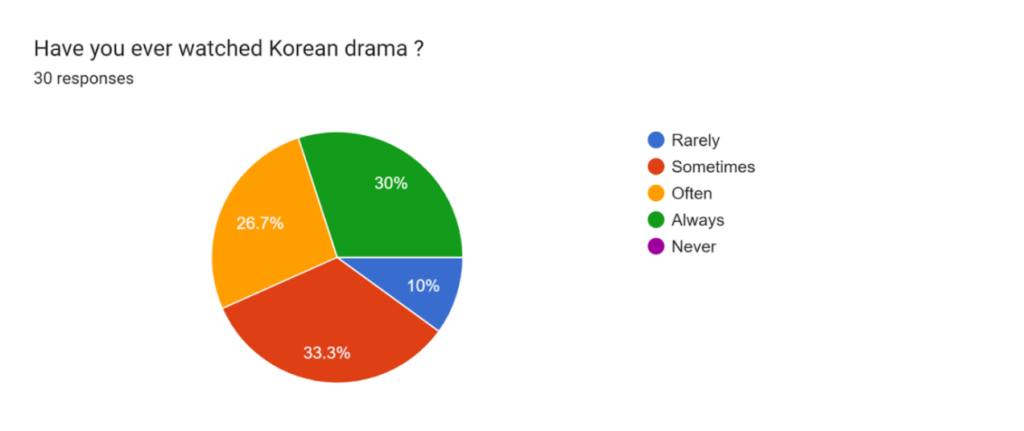
This figure summarizes the percentage of people who are familiar to or have watched Korean dramas. It is observed that 33.3% (10 out of 30) people sometimes watch Korean dramas forming majority. While 30% (9 out of 30) people always watch Korean dramas. 26.7% (8 out of 30) people often watch it and 10 %( 3 of 30) watch it rarely.
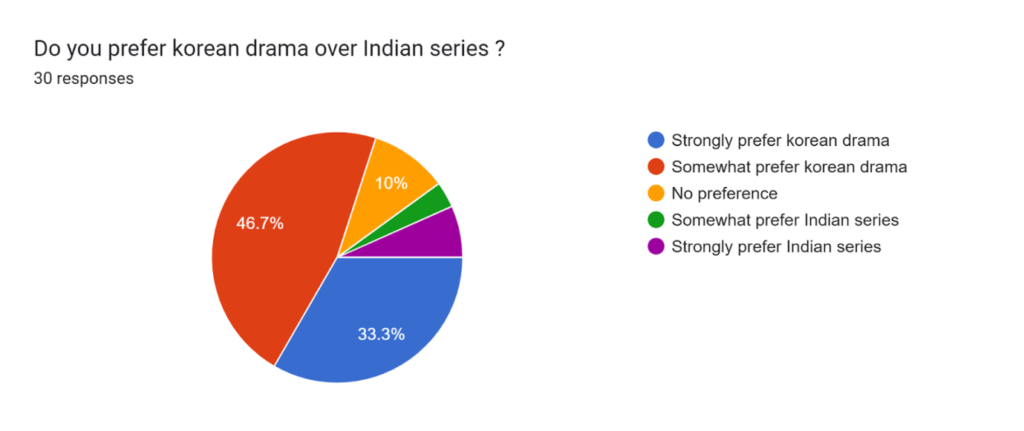
This figure summarizes that how many respondents prefer Korean dramas over Indian series to form base for further analysis. The majority of respondents 46.7 %( 14 out of 30) responded that they somewhat prefer Korean dramas. While 33.3 %( 10 out of 30) agreed that they strongly prefer Korean series. 10 %( 3 of 30) marked no preference and other 6.7 %( 2 out of 30) responded their strong preference is Indian series .While 3.3 %( only 1 out of 30) said Indian series is preferred somewhat over Korean.
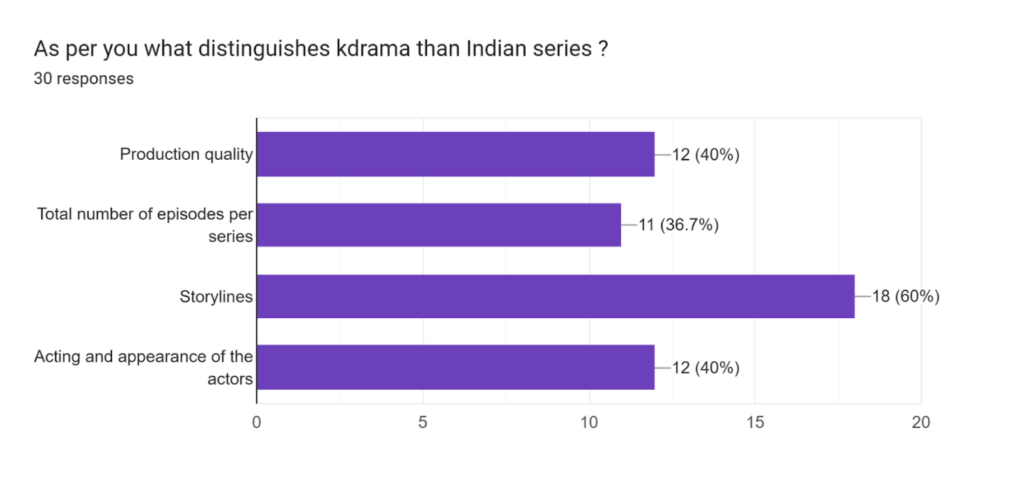
This figure elaborates what are the things that distinguish Korean and Indian series as per them. It was checkbox question that received storylines as the major difference (60% or 18 out of 30). Then it was a tie between production quality and acting and appearance of the actors as both received 40% (12 out of 30) responses each. Rest 36.7% (11 out of 30) find total number of episodes as the major difference.
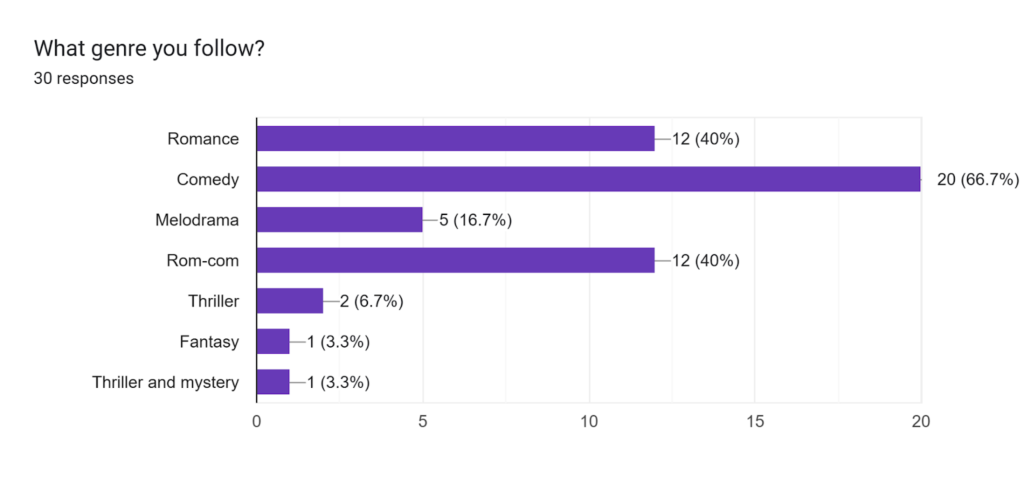
When asked about genre, comedy topped the list with 66.7 %( 20 out of 30 respondents enjoying comedy dramas. While 40 %( 12 out of 30) respondents also go for romance and rom-com genre. Rest respondents do watch other genres too like melodrama, thriller and mystery.
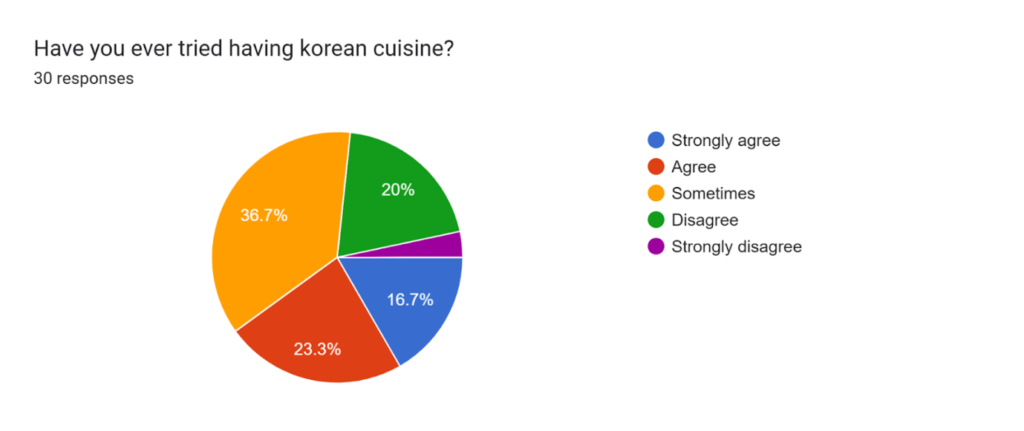
This figure implies that a great number of respondents36.7 %( 11 out of 30) try Korean cuisine sometimes. While 23.3 %( 7 out of 30) agreed that they had tried Korean cuisine. Furthermore, 20 %( 6 of 30) disagreed with the question while 3.3 %( 1 out of 30) strongly disagreed with the question.
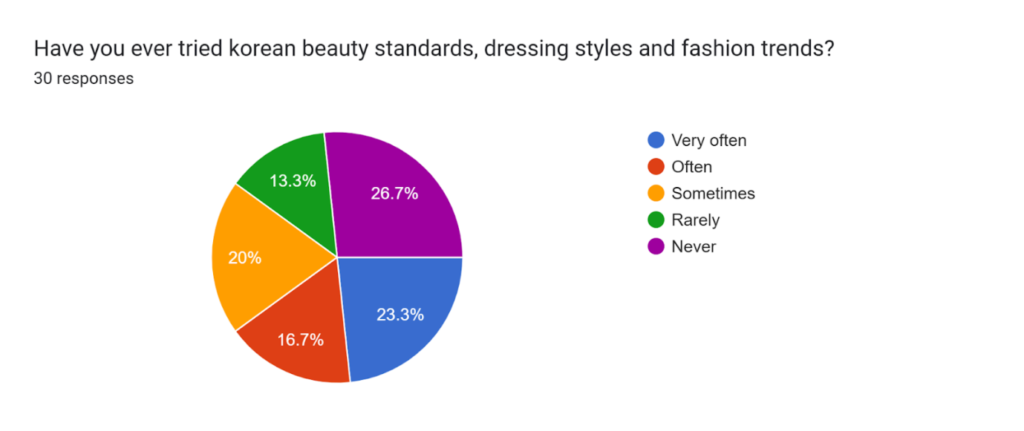
This figure summarizes the not so varied responses on trying Korean products. 26.7% (8 out of 30) responded that they had never tried Korean products. Alternatively, 23.3 %( 7 out of 30) agreed that they try Korean culture very often. Also, 20 %( 6 out of 30) try K-culture sometimes while 16.7 %( 5 out of 30) and 13.3 %( 4 of 30) responded often and rarely respectively.
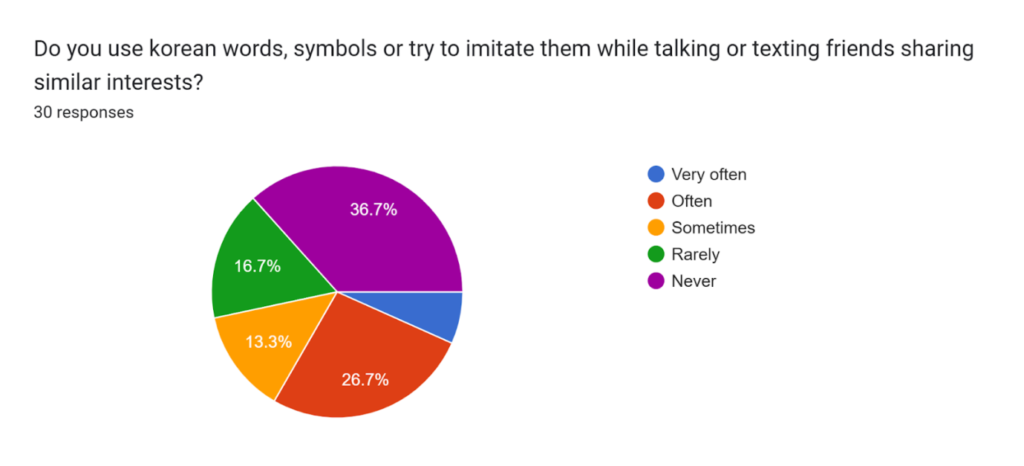
When talked about imitation of Korean lexicon, 36.7 %( 11 out of 30) responded that they never do so. While 25.7 %( 8 out of 30) responded positively that they often try to imitate Korean lexicon. Then comes 16.7 %( 5 out of 30) of respondents who rarely do it. Concurrently 13.3 %( 4 out of 30) respondents do it sometimes. In the mean time, only 6.7 %( 2 out of 30) try to imitate it very often.
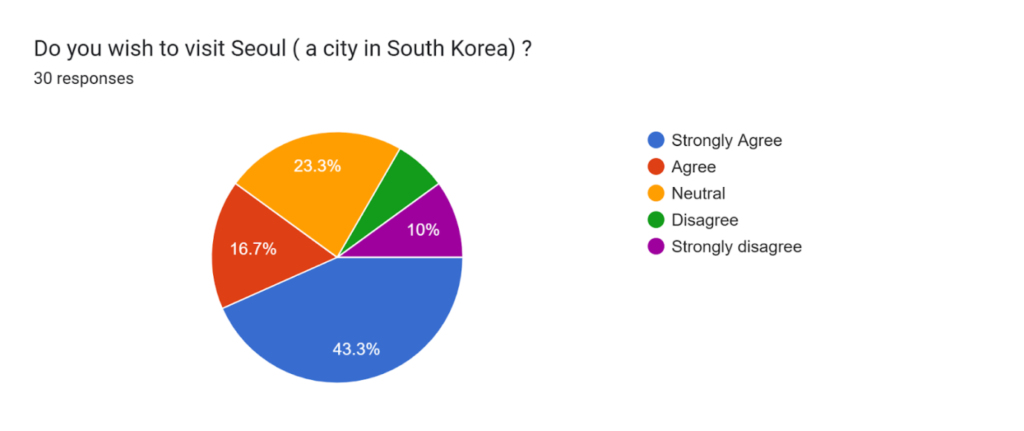
On the terms of visiting Seoul, 4.3 %( 13 out of 30) respondents want to visit Seoul strongly. 23.3 %( 7 out of 30) chose to stay neutral .While 16.7 %(5 of 30)agreed and 10%(3 out of 30) strongly disagreed. Furthermore, 6.7 %( 2 out of 30) choosing disagree.
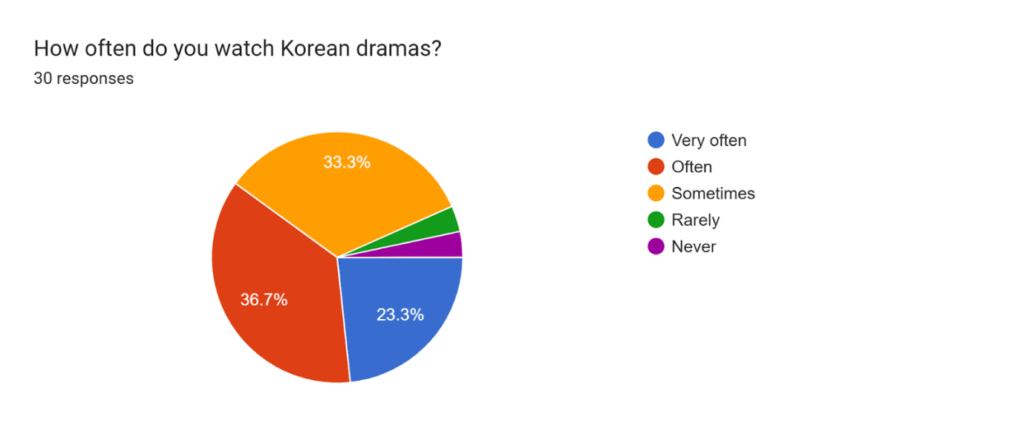
In order to analyze duration of watching, this question forms major respondents of 36.7 %( 11 out of30) answering with often. While, 33.3 %( 10 out of 30) agreed with sometimes. 23.3 %( 7 out of 30) of respondents watch it very often. Furthermore, 2 respondents making 3.3 %( 1 of 30) each responded with never and rarely respectively.
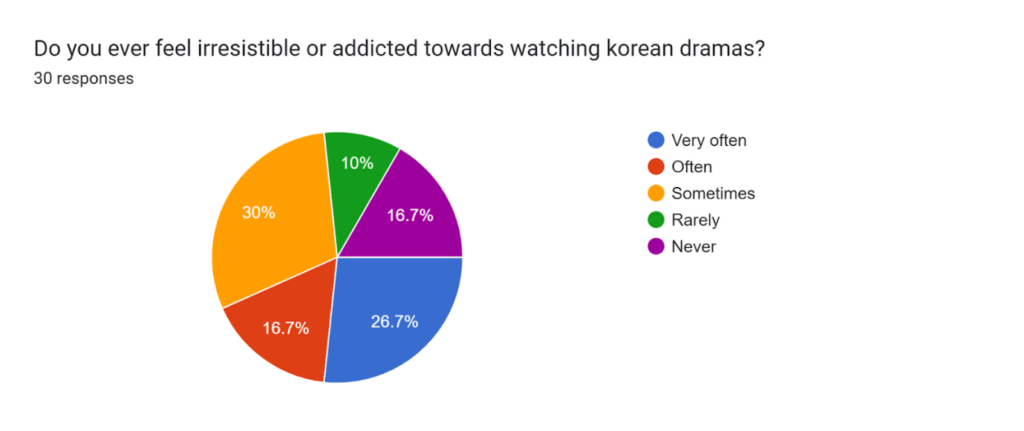
30 %( 9 out of 30) respondents sometimes feel irresistible while 26.7 %( 8 out of 30) feel it very often. There’s a tie between often and never as 16.7 %( 5 of 30) responded with never and often each. 10 %( 3 out of 30) feel irresistible rarely.
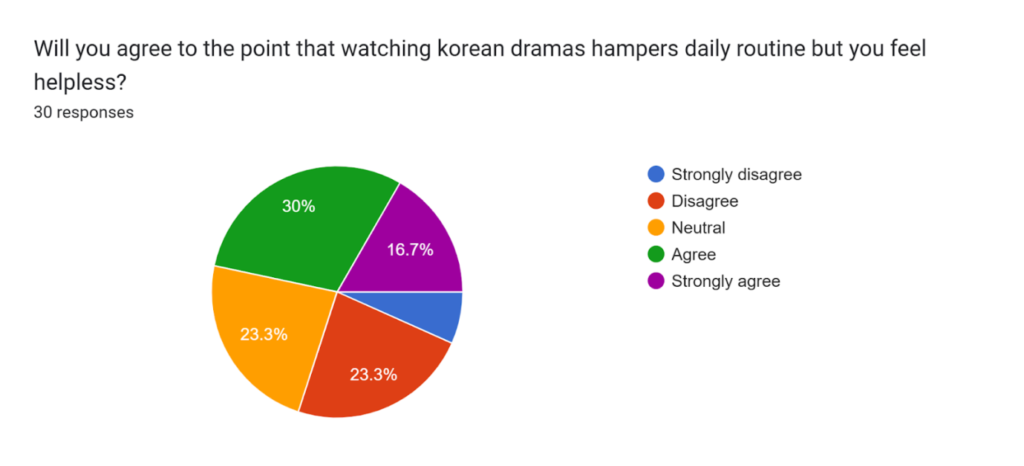
30%(9 out of 30) agreed to feel helpless but hampered .23.3%(7 out of 30) chose to be neutral and .23.3%(7 out of 30) disagreed with the question while 16.7%(5 out of 30) strongly agreed that they get hampered.6.7%(2 out of 30) strongly disagreed with the question.
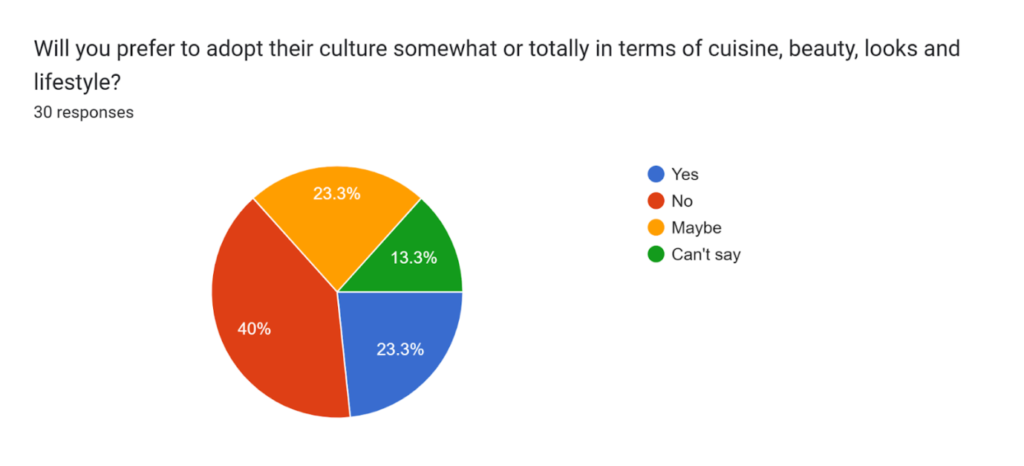
This question became a game changer as 40%(12 of 30) do not want to adopt Korean culture despite being fans of it. While 23.3 %( 7 of 30) nodded in yes and 23.3 %( 7 of 30) may adopt it. 13.3 %(4 of 30) can’t say about adoption.
Q) What you find most appealing in Korean actresses? 26 responses
Responses) For this open ended question, mixed responses were received but acting, looks and beauty topped the list.
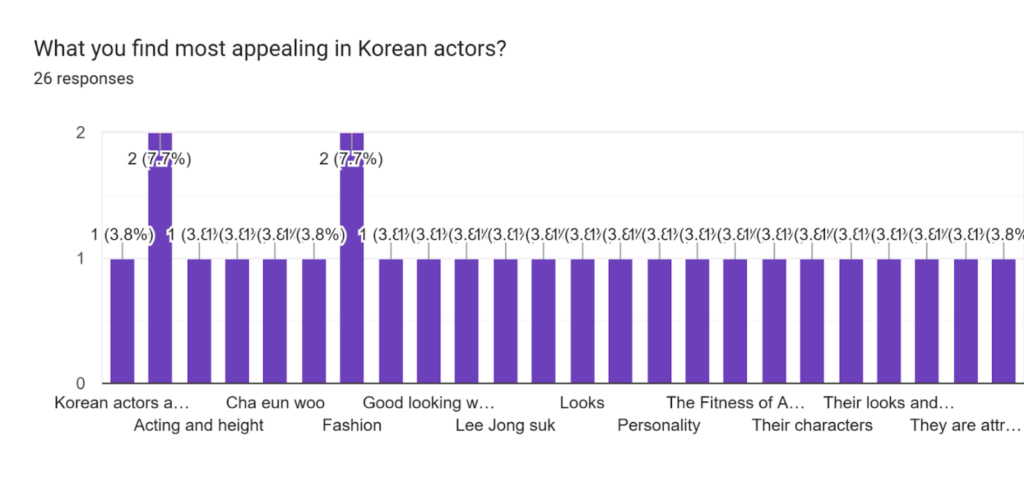
Acting and fashion of Korean actors is the most appealing to the respondents while their decent behavior was also praised.
Q) Something you wanted to share about your interest and love for Korean dramas like how you feel for it or so?
Responses) Plots and Storylines are the most loved thing of Korean dramas while most find it as comfort escapism from reality and their day to day hustle.
Conclusion
In conclusion, this study on adverse impacts of Korean dramas on Indian youth reveals that there is a significant impact of binge-watching on respondents of 16-25 years .The findings suggests that of all the factors affecting Indian youth, over consumption is leading to unrealistic perception that is causing imitation suppressing Indian culture in terms of cuisine, beauty and lifestyle, exceeding watching durations are leading to procrastinations and learning Korean vernacular is eroding Indian languages up to some extent. Majority of respondents feel addicted, irresistible towards watching and agree to the point that Korean dramas hampers productivity. However, it is crucial to note that majority of respondents apart from being consumers of Korean dramas are unwilling to adopt Korean culture indicating presence of heritage resilience.
The outcome implies that we reject all three above-mentioned null hypothesis as Korean dramas are shaping or hampering certain aspects of Indian youth that is causing imitation or unrealistic perception leading to increased love for Korean beauty or fashion products that is also a reason for lower self-esteem or self-doubt; cultural erosion with increased enrollments in Korean vernacular classes, and lesser self-control towards watching Korean dramas causing procrastinations and reducing productivity. Therefore, there is somewhat need for mature, balanced and responsible media consumption by Indian youth in order to stay entertained but also safe from the trap of negativities harming their social, personal and psychological health.
When it comes to the solution of this problem, here are few ways that can be considered to overcome or prevent harmful effects of binge-watching:-
- Schedule your day– Schedule your day a night before, set a fixed starting and ending leisure time for watching Korean dramas and going for only one-two episodes per day.
- Find alternatives– If you want to escape socialization being an introvert, you can go for healthy alternatives like comedy shows, documentaries or educational entertainment. It will also help in beating mental health issues like depression or so.
- Limit screen time– You can set screen time limit for watching Korean dramas using viewing restriction features.
- Seek support– Get aware of the content you’re watching, is it really required for your growth? Ask for help from trust worthies to overcome the addiction.
References
Works Cited
Challapalli, Panjwani, & Khan. (2021). A study of cultural impact of Hallyu (Korean Drama-Netflix)on indian viewers. Gap Parampara , 9.
Singh, & Saumya. (2022). The rise o Korean Wave in India and its Influence on Consumer Behaviour and Consumer Product Industry. SSRN , 49.
Viikki, & Jenna. (2023). SOCIAL CHANGE AND FEMALE DESIRABILITY IN CONTEMPORARY SOUTH KOREA: THE CASE OF HALLYU DRAMA. University of Jyvaskyla , 58.
Footnotes:
- Korikart is an online Korean product selling or shopping website importing products in Indian states
↩︎ - Aegyo : it is a term relating to the quality of being cute ↩︎



